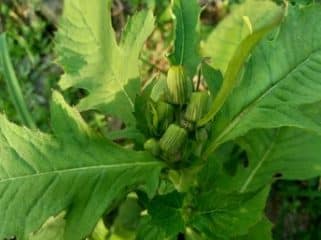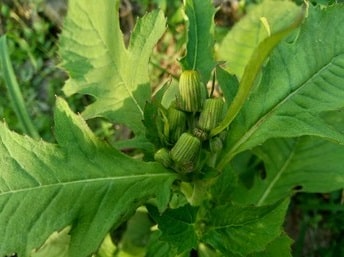- How to Identify Ebolo Vegetable
- Nutritional Information of Ebolo Vegetable
- Toxicity of Ebolo Vegetable
- Carcinogen
- Hepatotoxicity
- Health Benefits of Ebolo Vegetable
- Weight management
- Improved Cardiac health
- Indigestion Treatment
- Wound Treatment
- Headache relief
- Stomach Upset relief
- Conclusion
With the English name, fireweed or ragleaf, the health benefits of ebolo vegetable are numerous and it can be attested to by the older generation in the western part of Nigeria. A quick search on the internet provides you with recipes on how to prepare ebolo vegetable but they do not readily inform you of the benefits you stand to gain from consuming this vegetable and the possible dangers in consuming it.
Quick Facts About Ebolo Vegetables
| A | B |
|---|---|
| Name | Ebolo Vegetable |
| Scientific Name | Crassocephalum crepidioides |
| Origin | Tropical and subtropical Africa |
| Family | Asteraceae (Sunflower family) |
| Appearance | Tall, erect annual herb with soft, hairy leaves and clusters of small, yellow or orange flowers |
| Common Names | Ebolo, domoyo, dog's tooth lettuce, fireweed, thickhead |
| Taste | Slightly bitter with a hint of sweetness |
| Texture | Tender and slightly succulent |
| Culinary Uses | Commonly used in soups, stews, and salads in West Africa |
| Medicinal Properties | Traditionally used to treat a variety of ailments, including fever, cough, diarrhea, and stomach upset |
| Nutritional Value | Rich in vitamins A, C, and K, as well as minerals such as iron, calcium, and potassium |
| Availability | Fresh ebolo leaves can be found in markets in West Africa; dried leaves can be purchased online |
| Name in Other Languages | • Hausa: Babaku • Igbo: Alapolo • Yoruba: Ebolo • Chinese: ye tong hao • Fiji: pua lele; se vuka • Indonesia: jukut jamalok • Japan: benibanaborogiku • Java: jewor; sintrong • Papua New Guinea: thick head • Philippines: bulak manok • Samoa: fua lele; vao lele • Thailand: phak pet maeo • Tonga: fisi puna |
Ebolo vegetable is a common vegetable among the Yoruba people. It is not your regular vegetable as it is usually eaten once in a while due to its low level of production, compared to other vegetables. It is called Alapolo in Igbo, Babaku in Hausa, confirming its presence in the tropical parts of the world, especially in Africa.

The mucilaginous leaves of ebolo vegetable and the slightly succulent stem are the edible parts of the plant and they are rich in many nutrients one can expect from plants. These nutrients provide some benefits to its consumers.
At the end of this article, you will get the right name and identification of ebolo vegetable, instead of confusing with coriander or parsley, as most people do. You will also know the nutrients it contains, the health benefits of ebolo vegetable, and the possible toxins it contains.
How to Identify Ebolo Vegetable
Ebolo vegetable is often mistaken for parsley and coriander, even though they do not belong to the same family. This is probably due to the disinterest of the present generation in indigenous foods. However, ebolo vegetable is not difficult to distinguish from the aforementioned vegetables.
It has a succulent stem with its leaves spirally arranged around it. Although it is characteristically stout, it can grow to a height of about 100 cm and above. The leaves are pinnate and can be distinguished by their separation into different sections, usually three. Some of the leaves can have serrations at their edges. Its flowers are usually yellow or orange but have a reddish-brown top.
They are usually abundant during the rainy season as they are not usually sown, and are available when new yams are. Its characteristically strong aroma is another identification factor. It will always smell of the wild as the Yoruba adage says, hence, distinguishing it from other vegetables.
Nutritional Information of Ebolo Vegetable
Ebolo vegetable did not get its reputation as a beneficial vegetable by mere word of mouth, there are phytochemicals it contains to cement its health importance, although many still don’t know them. These nutrients influence the activities of the body, making them occur smoothly or with hiccups. Some of the nutrients in ebolo vegetable include:
| Nutrient | Composition |
| Moisture | 10.16% |
| Energy | 306.72 Kcal |
| Carbohydrate | 56.01% |
| Fiber | 13.27% |
| Protein | 15.09% |
| Lipids | 2.48% |
| Calcium | 105.09 mg |
| Manganese | 2.16 mg |
| Zinc | 0.09 mg |
| Iron | 1.92 mg |
| Potassium | 791.40 mg |
| Magnesium | 20.34 mg |
| Sodium | 64.86 mg |
| Copper | 0.14 mg |
Source: Researchgate
Other than the nutrients in ebolo vegetable, it is rich in phytochemicals, such as flavonoids, phenols, saponin, ascorbic acid, oxalate, phytate, and tannin.
Toxicity of Ebolo Vegetable
One may wonder, why does a vegetable with so many nutrients be neglected and produced in the minimum quantity? It is probably due to the unattractive aroma it gives off. Ebolo vegetable does not lose its aroma, no matter how well you cook it. This aroma has been linked to the probability that the toxins it contains give it off.
Carcinogen
The phytochemical, Jacobine, which is also a pyrrolizidine alkaloid, which occurs in plants and protects them from insect attack has been found in ebolo vegetable. Unfortunately, this phytochemical is also tumorigenic, that is, it causes cancer.
Hepatotoxicity
Also, the same phytochemical, Jacobine, has been tested and found to cause toxicity to the liver when consumed to a certain extent. Although this is a source of concern, it does not readily affect humans except when they are consumed in really high quantities. This is almost impossible, especially due to the repelling aroma it has.
Health Benefits of Ebolo Vegetable
Despite the bad news surrounding the palatability of ebolo vegetable, it is also important to note that it contains nutrients that are beneficial to the body of its consumers. Moreover, its toxicity is to protect itself from insect attacks, and it does not affect humans except they are consumed in very large quantities.
Some of the health benefits one can derive from ebolo vegetable, in agreement with its nutrient composition include:
Weight management
Weight is an important indication of one’s physical health as many medical conditions can make one either have a loss of appetite or eat excessively. When a person is above or below the normal body mass index, a problem is at hand.
However, to curb weight problems, as they are associated with many other health conditions, such as diabetes, depression, and anxiety, and obesity, among others, one needs a good amount of fiber in their diet, ebolo vegetable being a good source of that.
It is also rich in water, which together with its fiber content helps one get full faster while eating less than one would normally eat.
Related Article: 12 Best Fiber Foods in Nigeria
Improved Cardiac health
Good cardiac health needs the heart muscles to perform at optimum or near optimum capacity. To achieve this, the heart has to be rid of bad cholesterol, and minerals that help in regulating muscle contraction and relaxation have to be in abundance.
Ebolo vegetable is rich in minerals, such as potassium and magnesium, which are important in the regulation of muscular movement in the body. It is also low in lipids, which makes it a good choice for people seeking to reduce their lipid intake, ergo, a healthy cardiac system.
Indigestion Treatment
Ebolo vegetable is credited for helping to calm many stomach upsets and indigestion problems. Its abundance of fiber helps to move food materials along fast in the digestive system. It also helps to supply probiotics to the gut, improving digestion.
Wound Treatment
The healing of wounds goes through series of processes, one of which is inflammation. Ebolo vegetable is rich in flavonoids that help to treat inflammation, thereby, speeding up the wound healing process. Also, it disinfects the wound due to its antibacterial properties.
Headache relief
The leaves of ebolo are ground and essential oils containing α-farnesene, β-cubebene, and α-caryophyllene, are extracted. The essential oil from ebolo is useful in treating headaches, and it is commonly used in the Southern part of Nigeria.
Stomach Upset relief
Stomach upset, characterized by stomach rumbling, pain, and sometimes, diarrhea is treated with ebolo vegetable. It does this because it contains phytochemicals, such as phenols and flavonoids, which can function as an analgesic.
Conclusion
Ebolo vegetable is a seasonal leafy vegetable that grows in the tropical and subtropical climates of the world. it is more consumed in the southwestern part of Nigeria and helps to treat some health issues, such as epilepsy, stomach upset, and headaches, among others.
It is rich in nutrients, such as protein, carbohydrates, fiber, calcium, magnesium, and potassium, to name a few and abundant in phytochemicals such as flavonoids and oxalates. However, Jacobine – another phytochemical – may be toxic to the liver at certain levels.

